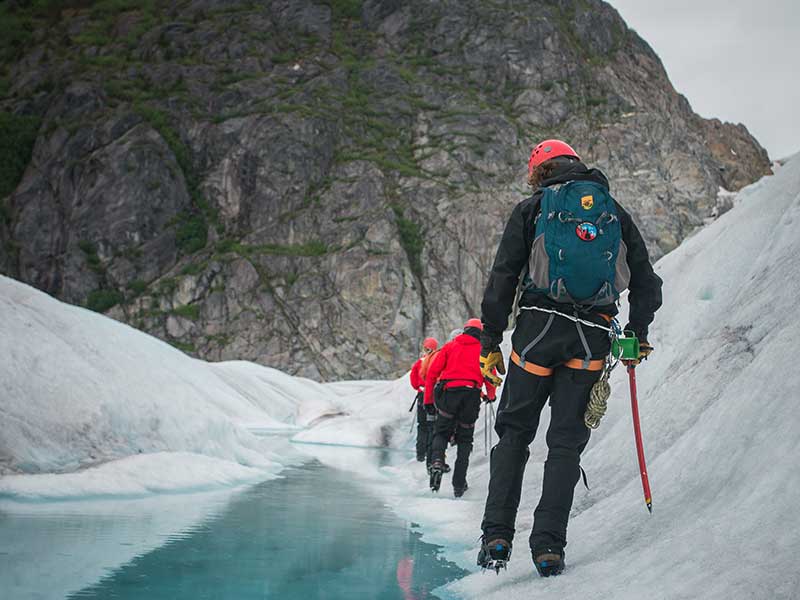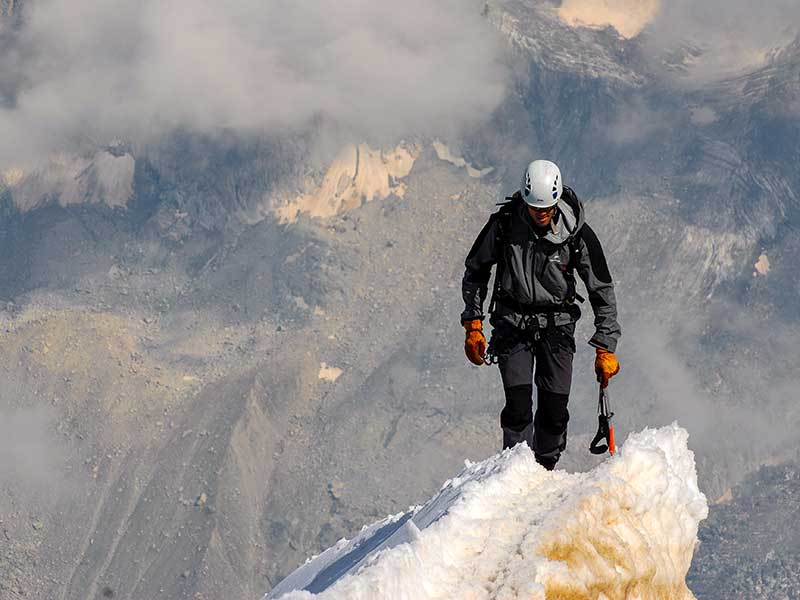Self-arrest, a fundamental safety technique in the mountains

The self-detention in the mountains with an ice axe stands out as an indispensable technique in the event of a fall in the winter mountains. Any mountain excursion involves a certain degree of risk. However, it is possible to minimise accidents by using appropriate techniques.
It should be noted that it is always absolutely necessary to have the advice of mountain experts or to take courses in order to be able to practice mountaineering with all possible safety.
What is self-stopping in the mountains?
In mountaineering, the technique of self-restraint is the technique that must be put into practice in practice in the event of a slip or fall on a slope.. In the winter mountains, this technique is applied on frozen or snowy slopes.
As with all the details that make up mountaineering, in order to practise self-arrest it is necessary to master the technique. It is not intuitive knowledge, but on the contrary, it must be learned: a fall in the mountains can be fatal.
For this reason, at the beginning of each winter season, it is a good idea to practise the different forms of self-arrest in the mountains so that you can use the correct technique when you need it most, i.e. if your life is in danger.
Self-restraint in the mountains can save your life
Falling backwards, feet first
In order to perform self-bracing in the event of a fall, it is necessary to have a ice axe. This tool must be held by the withers and by the blade. At the moment of the fall, it should be turned quickly over the hand and then crossed over the chest. In other words, the shovel will be placed on the upper part of the shoulder and the pickaxe will be ready to stick into the snow to break the fall.
One of your hands will hold the ice axe at the end of the handle, with your elbows close to your body, acting as a lever. This is the braking position and will stop the fall more quickly and effectively. This same position will be used in the other self-arrest techniques, although adjustments will be made for braking on different falls.
In the mountains, you will generally have crampons It is therefore important that the feet are raised during the fall to prevent the crampons from digging into the ice and causing a "crunch".catapult effect". This means that if the speed of the fall is too fast, the force of the fall will lift you off the ground when you put your crampons on the snow and make you fall violently towards the front.
Fall face forward, face down
When the fall is from the front, the ice axe should be stuck to the side of the body. This will allow the ice axe to act as a pivot. The whole body will turn to one side as the sliding speed of the fall slows and should end up in the standard braking position.
When falling from the front, the feet must be raised so that the crampons do not get stuck in the snow and act quickly with the ice axe. As mentioned above, the ice axe should be stuck into the snow to the side of the body and this will stop the fall, rotating the body until it becomes immobile.
Head down and face up
This type of fall is also often referred to as the the cat's downfall. It is also ranked by many mountaineers as the worst of all falls.
When falling in this position, with the head down and face up, the body must also pivot, with the ice axe as the axis. In other words, the body is sliding on the snow, and the person is looking skyward, with the head forward.
You will necessarily have to raise your feet a little to avoid the crampons digging into the ice, which could make the fall worse. The ice axe should then be driven into the snow, with the point of the ice axe to the side of the body.
This movement will allow the body to rotate and change posture, becoming stationary and face down in the braking position.

Practice makes perfect
Mountaineering experts point out that they always self-detention should be practised at the beginning of the winter season.. The reason is that it is always necessary for mountaineers to practice these techniques so that they can perform them effectively when falling.
The progression of mountain self-arrest practice should follow this principle: first, practice the techniques without crampons and backpacks so that you can concentrate on performing the manoeuvre correctly.
Once you have mastered the technique, practice self-stopping with your crampons on. Remember not to rest your crampons on the snow to avoid the "catapult effect".
Once you have mastered self-stopping with crampons, it is time to practice these manoeuvres. with a backpack on. Make sure that the rucksack is as heavy in practice as it is when you carry it for a hike. In this way, the practice of self-stopping will come closer to real-life circumstances.
Obviously, when practising self-arrest on a mountain, try to do it on a slope where there are safeguards to prevent you from continuing to slide out of control. You could injure yourself or someone else.
Precautions when making a self-detention in reality
- The practice of self-restraint in the mountains aims to make this technique become a self-reflectionThe longer you are falling, the longer it will take you to stop when making a self-arrest, so that you can perform the manoeuvre as soon as you start the fall, because it will be more effective. The longer you are falling, the longer it will take you to stop when performing the self-arrest.
- If you are on a tricky mountain pass and you are afraid of falling, be cautious and hold on the ice axe at the ready to perform a self-arrest in the event of a fall, i.e. holding the ice axe by the withers with one hand, slightly above the shoulder, and with the other hand holding it by the end of the shaft, so that it is crossed in front of your chest.
Fastpacking is not about going faster. It's about going lighter.
If you come from classic trekking, this is the next step: learning to move with less weight,
more fluid and enjoying every kilometre more.
Join the channel and start discovering what lightness feels like.
